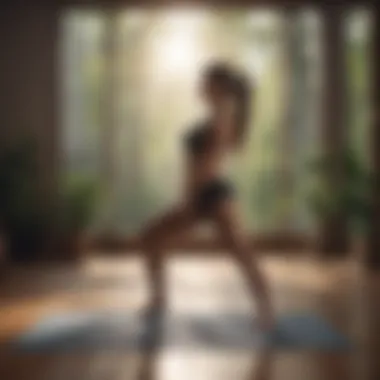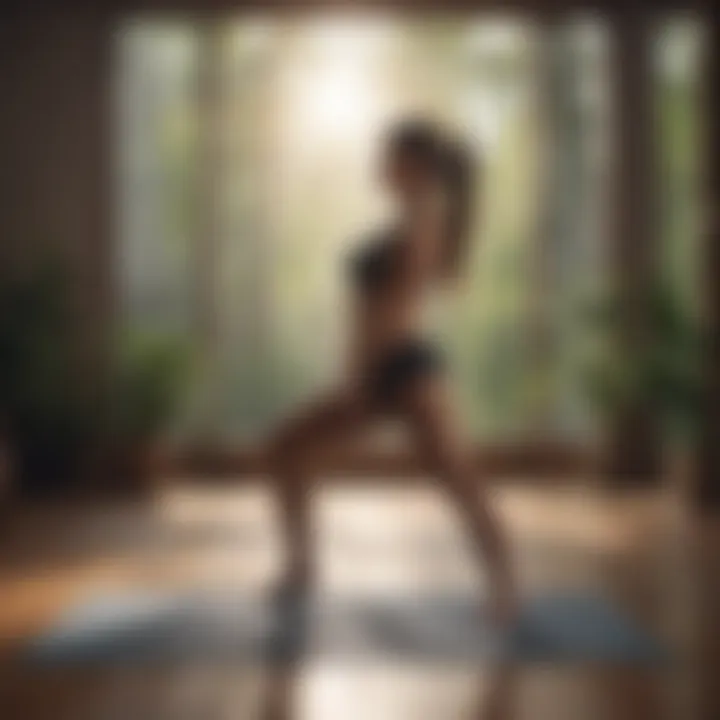Strategies for Relaxing the Body: A Comprehensive Guide


Research Overview
Prologue to the topic under study
Physical relaxation is crucial for maintaining overall health and well-being. In today's fast-paced world, stress can significantly impact our bodies, leading to various health issues. The exploreation of methods for promoting relaxation is essential. This guide aims to present evidence-based strategies that can help individuals reduce tension and enhance their physical well-being.
Summary of existing research findings
Research indicates that various relaxation techniques can effectively reduce physiological stress responses. Studies show that practices like mindfulness meditation, yoga, and progressive muscle relaxation significantly lower cortisol levels and improve emotional health. Furthermore, these methods can enhance sleep quality, reduce anxiety, and improve energy levels.
The connection between mind and body is clear from the vast number of studies proving how mental states can influence physical conditions and vice versa. Notably, the effectiveness of these methods varies among individuals, which underscores the importance of personalized approaches to relaxation.
Key research methodology explained
The methodologies used in these studies typically involve randomized controlled trials, meta-analyses, and longitudinal studies. Participants often engage in specific relaxation techniques under controlled conditions while their physiological responses are measured. The outcome measures generally include heart rate variability, blood pressure, cortisol levels, and self-reported stress levels. This rigorous approach ensures that the findings are robust and applicable across various demographics.
Health Implications
Discussion on the impact of the research on health
Understanding the importance of physical relaxation has profound health implications. Chronic stress is linked to numerous health problems, including hypertension, cardiovascular diseases, and mental health disorders. By reducing stress through effective techniques, individuals may not only improve their immediate well-being but also enhance their long-term health outcomes.
Exploration of potential benefits and risks
The benefits of engaging in relaxation practices are well-documented. Regular practice can lead to enhanced focus, reduced anxiety, and improved mood. However, it is crucial to recognize potential risks. For example, individuals with certain mental health conditions may find that some relaxation methods, like deep breathing exercises, could intensify anxiety in the short term.
Examples of how the findings can be applied in daily life
Incorporating relaxation strategies into daily routines can be simple and effective. For instance, setting aside time for gentle yoga or brief mindfulness sessions can be done at home or even in a workplace setting. Crafting a personalized schedule that includes these practices is vital for long-term adherence.
Well-being Strategies
Practical tips and strategies derived from the research
To promote effective relaxation, here are several practical tips:
- Mindfulness Meditation: Spend a few minutes each day focusing on your breath. This technique enhances awareness of the present moment.
- Progressive Muscle Relaxation: Gradually tense and then relax each muscle group. This helps to relieve physical tension.
- Gentle Yoga: Engage in slow, controlled movements to stretch and relax the body.
Advice on implementing positive changes for well-being
When implementing these strategies, consider starting with short sessions and gradually increasing the duration as comfort builds. Use mobile apps to guide mindfulness or meditation practices, as these resources can provide structure and motivation.
Personal stories or case studies supporting the strategies
Many individuals have reported positive experiences with these techniques. For example, a participant in a study on yoga noted significant improvements in mood and stress levels after committing to a daily practice. These testimonials align with research findings, reinforcing the efficacy of structured relaxation techniques.
Expert Insights
Analysis of expert opinions on the research findings
Experts in the field stress the importance of finding the right strategy for each individual. Different methods resonate with different people, making personalized approaches essential. Furthermore, combining techniques—such as yoga with mindfulness—can lead to cumulative benefits, enhancing overall outcomes.
Q&A session with a relevant expert on the topic
While conducting this research, insights from practitioners and researchers provided clarity on complex issues. One expert stated, "Finding balance is the key. Adaptation and flexibility in approach can lead to sustained improvement in well-being."
Links to related articles or studies for further reading
Recommended books, websites, or courses for in-depth learning
- The Relaxation Response by Herbert Benson
- Wherever You Go, There You Are by Jon Kabat-Zinn
Tools or apps that can assist in applying the research findings
- Headspace
- Calm
Implementing these findings can help foster a deeper sense of well-being, contributing positively to physical health.
Understanding Relaxation
Understanding relaxation is essential as it unravels the complexities of how the body and mind respond to stress. This section emphasizes that relaxation is not a mere absence of tension but a state that fosters physical, emotional, and mental well-being.
Definition and Importance


To define relaxation, it is crucial to recognize it as a physiological response characterized by a decrease in metabolic activity, heart rate, and blood pressure. It involves a shift from the body’s stress response to a state of calmness. Importantly, relaxation plays a vital role in maintaining overall health. It aids in reducing stress levels that accumulate due to daily life pressures. Chronic stress can lead to various health issues, including cardiovascular diseases, anxiety, and depression. By incorporating relaxation techniques, individuals can mitigate these risks and improve their quality of life.
The Science of Relaxation
The science of relaxation involves understanding its effects on the body through various mechanisms. When a person engages in relaxation practices, the body releases neurotransmitters like serotonin and endorphins, which promote feelings of well-being.
"Research indicates that regular relaxation practices can enhance mood and reduce feelings of anxiety."
Moreover, the process triggers the parasympathetic nervous system, responsible for the body's rest and digest functions. This response not only lowers heart rate and blood pressure, but also improves digestion and enhances immune function.
In summary, recognizing the importance of relaxation and understanding the science behind it can significantly improve health outcomes. It lays a foundation for adopting effective strategies to combat stress and promote relaxation.
The Role of Stress in the Body
Understanding the role of stress is essential for grasping how to effectively relax the body. Stress, in various forms, can trigger a cascade of physiological changes. This often results in a state known as "fight or flight," which, while beneficial short-term, can lead to long-lasting issues if not managed. The exploration of stress is crucial as it sets the foundation for comprehending many relaxation strategies discussed later in this guide. Recognizing the different dimensions of stress — physical, emotional, and mental — allows individuals to identify suitable methods for alleviating its impact on health.
Physical Effects of Stress
Stress manifests physically in several ways. When an individual encounters stressors, the body releases hormones like adrenaline and cortisol. These hormones prepare the body to react to threats but can also lead to negative physical outcomes if their levels remain chronically elevated.
Some common physical effects of stress include:
- Increased heart rate: Stress can cause a rapid heartbeat, which strains the cardiovascular system.
- Muscle tension: Muscles tighten and may lead to discomfort or chronic pain.
- Digestive issues: Stress can disrupt normal digestive function, resulting in stomach ache or altered appetite.
- Immune suppression: Chronic stress may weaken the immune response, making the body more susceptible to infections.
Understanding these physical effects is vital. Recognizing how stress adversely affects the body can motivate individuals to engage in relaxation strategies designed to counteract these symptoms.
Emotional and Mental Consequences
Stress not only affects the body but also has significant emotional and mental repercussions. Prolonged exposure to stressors can lead to various emotional disorders and cognitive impairments.
Some emotional and mental consequences include:
- Anxiety and depression: These conditions often arise as a result of unchecked stress, diminishing quality of life.
- Difficulty concentrating: Stress can cloud thinking and hinder decision-making abilities.
- Mood swings: Individuals may experience irritability or heightened emotional responses, influencing relationships and social interactions.
- Sleep disturbances: Stress can disrupt sleep patterns, leading to insomnia or restless nights, which can exacerbate the cycle of stress.
It is essential to acknowledge these consequences for personal insight into how both physical relaxation and mental clarity can effectively be achieved. Stress management activities can bring balance, fostering a healthier emotional and cognitive state.
Chronic stress may result in permanent changes to brain function, underscoring the importance of its effective management.
By understanding both the physical and emotional toll of stress, readers can better appreciate the necessity of various relaxation techniques and how they might be integrated into daily life.
Mindfulness Practices
Mindfulness practices play a crucial role in fostering relaxation and enhancing overall well-being. They encourage individuals to engage in the present moment, allowing for a greater awareness of thoughts and feelings. This awareness can reduce the impact of stress, anxiety, and physical discomfort. By incorporating mindfulness into daily life, one can manage responses to stressful situations more effectively.
Meditation Techniques
Meditation techniques are diverse, catering to various preferences and lifestyles. Common methods include focused attention, loving-kindness, and transcendental meditation. Each technique emphasizes quieting the mind and redirecting thoughts.
- Focused Attention: This method involves concentrating on a single point, such as breath or a mantra. The aim is to maintain focus and gently return to the point of concentration when distractions arise.
- Loving-Kindness: This fosters compassion, starting with yourself and expanding feelings of love towards others. Practicing loving-kindness can create a sense of connection and positivity.
- Transcendental: This form utilizes a specific mantra, repeated silently. Practitioners often find it promotes a deep state of rest, helping to alleviate stress.
The benefits of meditation include improved emotional regulation, enhanced self-awareness, and a reduction in symptoms of anxiety and depression. For those new to meditation, it can be helpful to start with shorter sessions, gradually increasing duration as comfort with the practice develops.
Breathing Exercises
Breathing exercises are simple yet powerful tools for relaxation. The focus is on breath control, which can calm the nervous system. There are several techniques to explore:
- Diaphragmatic Breathing: This involves breathing deeply, allowing the diaphragm to engage fully. It can slow the heart rate and lower blood pressure.
- 4-7-8 Breathing: Inhale for four seconds, hold for seven, and exhale for eight. This rhythmic pacing can promote relaxation fast.
- Box Breathing: Inhale, hold, exhale, and hold each for a count of four. This method is especially useful in stressful situations, bringing immediate calmness.
Regular practice of these exercises can lead to reduced anxiety levels, improved sleep quality, and an overall increase in those feelings of relaxation. It is recommended to find a quiet place and practice these exercises daily for best results.
Body Scan Method
The body scan method is a mindfulness technique aimed at increasing awareness of physical sensations throughout the body. It encourages individuals to focus on each body part, promoting relaxation and connection between the mind and body.
To practice, find a comfortable position lying down or sitting. Then, systematically focus on each part of the body, starting from the toes and gradually moving up to the head. Notice any sensations—tension, relaxation, warmth—without judgment. This exercise can enhance awareness of bodily sensations, leading to reduced stress and anxiety.
"Mindfulness is the first step towards understanding the self and recognizing how the body responds to stress."
In summary, integrating mindfulness practices into daily routines offers substantial relaxation benefits. Meditation techniques, breathing exercises, and the body scan method provide practical ways to cultivate mindfulness. Regularly engaging in these practices leads to greater emotional balance and resilience against daily stressors.
Physical Techniques for Relaxation
Physical techniques for relaxation play a crucial role in enhancing one’s well-being. They address the physical manifestation of stress and tension, which often builds up in the body. Engaging in physical relaxation methods can lead to improved body awareness, which is essential for managing stress effectively. These techniques not only help in alleviating immediate discomfort but also contribute to long-term wellness by promoting a state of calmness. Moreover, physical activities facilitate the release of endorphins, the body's natural painkillers, which can enhance mood and promote overall relaxation.
Yoga and Stretching


Yoga is a versatile practice that integrates physical movement, breath control, and meditation. Stretching movements in yoga help to gently elongate muscles and release tension throughout the body. Various poses promote flexibility and strength, which are vital for maintaining physical health. This practice also encourages mindfulness, as participants are guided to focus on their breath and the sensations within their bodies.
Consider incorporating the following elements into your yoga routine:
- Breath Awareness: Pay attention to your breathing as you move through poses. This can significantly enhance the quality of relaxation.
- Mindful Transitions: When shifting from one pose to another, be deliberate. This fosters a deeper connection between the body and mind.
Regular practice can lead to reduced anxiety levels and improved emotional regulation. A consistent yoga routine can also create a habitual space for relaxation within one's daily life.
Progressive Muscle Relaxation
Progressive Muscle Relaxation (PMR) is a systematic technique that involves tensing and relaxing different muscle groups in the body. The process typically starts from the feet and moves upward, allowing for comprehensive relaxation throughout the body. For instance, you may start by clenching the muscles in your feet for a few seconds before releasing them.
To effectively practice PMR:
- Find a Quiet Space: Choose a comfortable environment where you won’t be disturbed.
- Focus on Sensations: Notice the difference between tension and relaxation. This can enhance body awareness.
- Practice Regularly: Consistency can improve effectiveness, making it easier to combat stress when it arises.
Many individuals who adopt PMR report a noticeable decrease in stress-related symptoms and restored feelings of calmness.
Tai Chi and Qigong
Tai Chi and Qigong are ancient Chinese practices that combine smooth movements, controlled breathing, and mindfulness. These techniques are gentle and can be practiced by individuals of all ages and fitness levels. The slow, flowing movements help foster a sense of internal balance and relaxation.
Key aspects include:
- Mindful Movement: Each movement is performed slowly and deliberately, promoting a meditative state.
- Breath Coordination: Breathing is synchronized with movements, further enhancing relaxation.
- Focus on Energy Flow: Practitioners often concentrate on the flow of energy through the body, which can reduce stress and improve overall health.
Engagement in Tai Chi and Qigong can lead to improved mental clarity, reduced anxiety, and a deeper connection to one’s body.
Incorporating physical techniques into daily life can transform how one interacts with stress and promote a lasting state of relaxation.
Hydrotherapy for Relaxation
Hydrotherapy is an effective method for promoting relaxation through the use of water. This technique utilizes water's physical properties to soothe and invigorate the body. It encompasses various practices that range from warm baths to cold water treatments. Hydrotherapy is important in this article as it offers a tangible approach to managing stress and enhancing well-being. This section will explore both warm baths and cold water immersion, highlighting their benefits and practical applications.
Warm Baths and Showers
Warm baths and showers create an environment conducive to relaxation. The heat from the water helps to increase blood circulation, reducing muscle tension and alleviating pain. Immersing the body in warm water encourages the release of endorphins, which are natural pain relievers. This process not only promotes physical comfort but can also lead to significant improvements in mental clarity and emotional well-being.
A warm bath is often viewed as a luxury, but its benefits deserve everyday consideration. It is especially useful before bedtime, as it can help regulate body temperature and signal to the body that it is time to rest. Adding Epsom salts or essential oils like lavender to the bath can enhance the experience further. Here’s a simple routine:
- Prepare your bath: Fill a tub with warm water. Ensure the temperature is comfortable, not too hot, to avoid overheating.
- Add calming elements: Integrate Epsom salts or essential oils.
- Limit distractions: Turn off lights and use candles for a calming atmosphere.
- Sit back and relax: Spend at least 15 to 30 minutes soaking.
Cold Water Immersion
Cold water immersion may initially seem counterintuitive for relaxation, but its benefits are noteworthy. This practice has gained popularity due to its invigorating effects and is often employed in sports recovery. Cold water stimulates the body’s circulatory system, promoting blood flow and helping to flush out metabolic waste. It can significantly lower body temperature and reduce inflammation after intense activity.
In addition to physical benefits, cold water exposure can enhance mental resilience. Many athletes and wellness enthusiasts report increased mood and energy levels following cold immersion. Here are key steps for incorporating cold water immersion:
- Choose the right setting: If accessible, consider a cold plunge pool, lake, or shower.
- Start gradually: If new to this practice, begin with short stints, gradually increasing duration.
- Focus on breath: Use calming breathing techniques to ease into the cold sensation.
- Warm up afterward: Always follow with a warm shower or bath to help the body adjust back to a comfortable temperature.
"Incorporating hydrotherapy into your routine can bring both immediate and long-term benefits for physical and mental relaxation."
The Role of Nutrition in Relaxation
Nutrition plays a significant role in a person's overall well-being. The foods we consume can directly influence our mood, energy levels, and overall relaxation. A well-balanced diet helps in managing stress and promoting a state of calmness. This section will discuss how certain foods can aid relaxation, as well as the impact of stimulants like caffeine and sugar on the body.
Foods that Promote Relaxation
Various foods have components that may help foster a sense of tranquility. Some examples include:
- Leafy Greens: Vegetables like spinach and kale are rich in magnesium. Magnesium has been shown to reduce anxiety and improve sleep quality.
- Fatty Fish: Fish such as salmon and mackerel are high in omega-3 fatty acids. These acids are known for their anti-inflammatory properties and help in regulating mood.
- Nuts and Seeds: Almonds, walnuts, and flaxseeds can be good sources of vitamin E and other nutrients that support brain health.
- Whole Grains: Foods like brown rice and oats are rich in complex carbohydrates. They can increase the production of serotonin, the chemical responsible for making you feel relaxed and happy.
- Fruits: Berries and bananas contain antioxidants and potassium, helping to reduce stress.
Incorporating these foods into your daily diet can contribute to a more relaxed state of being.
The Impact of Caffeine and Sugar
Caffeine and sugar are common in many diets but can have adverse effects on relaxation. The way they affect the body is essential to understand.
- Caffeine: Found in coffee, tea, and certain sodas, caffeine is a stimulant that can enhance alertness but may lead to increased anxiety. Overconsumption can interfere with sleep patterns, making it harder to relax at night. Reducing caffeine intake, especially in the afternoon and evening, can help promote better rest.
- Sugar: High sugar intake can result in fluctuations in energy levels. The body experiences quick spikes and subsequent drops in blood sugar, leading to feelings of irritability and fatigue. This rollercoaster effect can increase stress. Reducing added sugars may help maintain more consistent energy levels, positively influencing the ability to unwind.
A balanced diet helps the body and mind maintain stability. Avoiding excessive caffeine and sugar can promote a better state of relaxation.
Ultimately, the role of nutrition cannot be overstated. Paying attention to what you consume can lead not only to improved physical health but also to greater mental clarity and emotional well-being.
Environmental Factors


Environmental factors play a significant role in promoting relaxation and supporting overall well-being. The surroundings in which one spends time can greatly affect mood, stress levels, and the ability to unwind. This section explores specific aspects of the environment that can either facilitate or hinder relaxation. By understanding these elements, individuals can make informed choices to cultivate a more peaceful and serene atmosphere.
Creating a Relaxing Space
Creating a relaxing space is not merely about aesthetics; it involves deliberate choices that cater to the senses. A well-designed environment can help diminish stress and enhance relaxation. A few crucial elements include:
- Colors: Soft, muted colors tend to have a calming effect. Shades like light blue, green, and lavender can create a tranquil atmosphere.
- Lighting: Natural light is ideal. When this is not possible, opt for soft, warm lighting options that mirror the sun’s glow. Avoid harsh fluorescent lights, which may increase feelings of tension.
- Sound: Ambient sounds can promote relaxation. Soft music or natural sounds like water flowing can ease the mind. Avoid disruptive noises that may distract or disturb the calm.
- Aromatherapy: Scents can trigger emotional responses. Essential oils like lavender, chamomile, and sandalwood are known for their relaxing properties and can be diffused in the space or used in massages.
Incorporating plants can also freshen the air. Greenery not only adds a visual element but also has been shown to improve mood and lower stress. The presence of comforting textures, such as soft cushions or warm blankets, can further enhance a comforting space.
"The environment we create affects how we feel; it is essential to be mindful of our surroundings to promote a sense of calm and relaxation."
The Influence of Nature
Nature can significantly impact relaxation and mental health. Research indicates that exposure to natural environments yields measurable benefits. Some ways nature influences relaxation include:
- Stress Reduction: Being in natural settings has been linked to lower cortisol levels, which are often elevated due to stress. Natural landscapes can serve as a retreat from the hustle of daily life.
- Enhancing Mood: Nature can provide feelings of joy and satisfaction. Many people find that walking in a park or hiking in the woods helps to lift their spirits.
- Improved Focus: Studies show that spending time in nature can enhance cognitive function and improve concentration. This heightened focus contributes to a greater sense of clarity and calm.
There are several easy ways to integrate nature into daily life. One can start by creating a garden or visiting local parks regularly. Even having indoor plants can provide a mini escape while refreshing the air.
In summary, both the physical space we inhabit and our connection to nature are vital to fostering relaxation. By understanding and implementing these environmental factors, one can facilitate a more restorative atmosphere conducive to well-being.
Integrating Relaxation into Daily Life
Integrating relaxation into daily life is essential for maintaining overall health and well-being. The modern world often encourages constant busyness and productivity, which may lead to increased stress and decreased mental and physical health. Understanding how to incorporate relaxation methods into one's routine can significantly improve quality of life. Effective relaxation strategies not only reduce immediate stress but also enhance long-term resilience against stressors, leading to better health outcomes.
Routine Development
Developing a routine that includes relaxation is crucial for busy individuals. Establishing a regular time for relaxation helps the body and mind anticipate downtime, making it easier to unwind. Here are some helpful steps for creating an effective routine:
- Identify time slots: Start by assessing your daily schedule. Look for natural breaks or openings in your day. Mornings or evenings can be ideal for relaxation.
- Set specific relaxation activities: Decide on particular relaxation methods. This could be yoga, meditation, or even reading. Choose activities that resonate with you.
- Consistency is key: Stick to your schedule as much as possible. By regularly following your relaxation routine, your body will start recognizing and responding to these times to relax.
"Establishing a regular routine is like training your mind to recognize when it’s time to relax."
Time Management Strategies
Efficient time management allows space for relaxation amidst daily responsibilities. To achieve this, individuals should consider the following strategies:
- Prioritize tasks: List your tasks in order of importance. Understanding what must be done can help reduce feelings of being overwhelmed and allocate time more effectively.
- Set boundaries: Limit work time and digital distractions. Choosing specific hours to focus on work and disconnecting afterward allows for uninterrupted relaxation time.
- Use timers: Employ the Pomodoro technique or similar methods to break work periods into manageable segments interspersed with short relaxation breaks. This enhances productivity and incorporates necessary rest.
Incorporating these elements can lead to a more balanced life. By intentionally integrating relaxation into daily activities, you not only enhance your mental state but also improve physical aspects of health.
Monitoring and Adjusting Practices
Monitoring and adjusting practices are critical in the realm of relaxation techniques. These steps help ensure that individuals can effectively manage their stress levels and maintain a state of physical ease. Regular monitoring allows one to evaluate the effectiveness of their relaxation strategies. This process helps individuals understand which methods yield positive outcomes and which may need modification or improvement.
Benefits of these practices include enhanced self-awareness, and a deeper understanding of one’s body responses. Regular check-ins can also prevent the escalation of stress, promoting a proactive approach to mental well-being. Considerations include understanding personal triggers and recognizing the need for adjustments in one's routine.
Self-Assessment Techniques
Self-assessment techniques provide a framework for individuals to evaluate their stress levels and the effectiveness of their relaxation practices. Simple methods such as maintaining a daily journal can be an effective way to document feelings, physical sensations, and triggers throughout the day.
Individuals might consider rate their stress levels on a scale from one to ten. This rating can help recognize patterns related to specific activities or environments. Furthermore, mindfulness check-ins can be beneficial. Individuals can take a few moments to reflect on how their body feels, whether they are relaxed or tense. Questions to consider include:
- Am I holding tension in certain areas, such as shoulders or jaw?
- How does my breathing feel? Is it shallow or deep?
Seeking Professional Guidance
Seeking professional guidance can be a pivotal step in enhancing relaxation practices. A healthcare professional, like a therapist or counselor, can offer tailored strategies that align with an individual’s unique needs. Expertise can also help identify underlying issues contributing to stress, which may not be apparent through self-assessment alone.
Additionally, professionals can introduce evidence-based methods such as cognitive-behavioral therapy or tailored mindfulness training. These approaches will equip individuals with tools to confront stressors in more effective ways. Professional guidance also offers a supportive environment to explore emotions, ensuring a comprehensive approach to well-being.
The End
The conclusion is a pivotal section of this article, encapsulating the critical insights into the diverse strategies for relaxation. It reiterates how these practices can fundamentally enhance physical health and psychological well-being. An effective relaxation strategy serves not just as a temporary escape from stress, but rather a lifestyle choice that can contribute to overall resilience against life’s pressures.
Summary of Relaxation Techniques
Relaxation techniques discussed include:
- Mindfulness Practices: Techniques such as meditation and breathing exercises help center the mind, reducing anxiety and promoting calmness. Regular engagement in these practices cultivates a more focused and serene mental state.
- Physical Techniques: Activities like yoga, progressive muscle relaxation, and tai chi harness movement and focused attention to unknott the tension in the body. These methods not only relax muscles but can also improve flexibility and balance.
- Hydrotherapy: Utilizing warm baths and cold water immersion can have soothing effects on muscles and help lower stress levels effectively. Water-based therapies have a significant physiological benefit, contributing to overall relaxation.
- Nutritional Support: Understanding the impact of nutrition, including the consumption of relaxation-promoting foods while limiting stimulants like caffeine, can further bolster the body’s ability to unwind and recharge.
- Environmental Adjustments: Creating a designated space for relaxation and incorporating elements of nature into daily routines supports a calming environment. This setting can be crucial in reinforcing relaxation habits and minimizing distractions.
- Routine Integration: Developing a consistent routine for relaxation practices is fundamental. Managing time effectively allows for dedicated moments of calm in a busy schedule, making relaxation part of one's daily life rather than a seldom indulgence.
In summary, the various relaxation techniques provide a holistic approach to improving one's well-being, preparing the individual to handle stress effectively.
Encouragement for Lifelong Practices
Integrating relaxation techniques into everyday life should not be viewed as a temporary fix. Instead, it is essential to approach these practices as lifelong commitments for maintaining health.
- Establish Consistency: Regular practice of relaxation methods fortifies their benefits. This could mean setting aside specific times in the day dedicated to mindfulness or physical activity.
- Adapt Practices: As life evolves, so too should relaxation methods. Being open to new practices or adjusting existing ones can ensure continued relevance and engagement.
- Commit to Change: Understanding the long-term effects of stress demands a proactive approach. Encouragement to continually explore and integrate relaxation strategies helps in establishing a balanced lifestyle.
Incorporating these techniques not only enhances personal well-being but also promotes resilience against stressors. Adopting an attitude of lifelong practice can profoundly affect one’s overall quality of life, contributing to both mental clarity and physical health.



